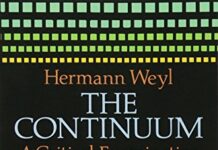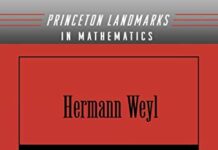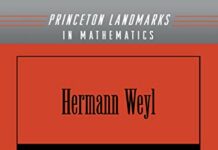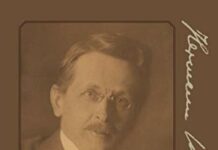
Ebook Info
- Published: 2020
- Number of pages: 894 pages
- Format: PDF
- File Size: 38.42 MB
- Authors: Hermann Weyl
Description
This landmark among mathematics texts applies group theory to quantum mechanics, first covering unitary geometry, quantum theory, groups and their representations, then applications themselves – rotation, Lorentz, permutation groups, symmetric permutation groups, and the algebra of symmetric transformations. Hermann Weyl was one of the most influential mathematicians of the twentieth century. Along with his fundamental contributions to most branches of mathematics, Hermann Weyl (1885-1955) took a serious interest in theoretical physics. In addition to teaching in Zürich, Göttingen, and Princeton, Weyl worked with Einstein on relativity theory at the Institute for Advanced Studies. “A classic of physics . . . the first systematic presentation of Einstein’s theory of relativity.” – British Journal for Philosophy and Science
User’s Reviews
Reviews from Amazon users which were colected at the time this book was published on the website:
⭐Weyl was ahead of his time by a good 40 years. Following a general introduction to quantum mechanics and group theory Weyl explores the ideas of applying symmetry groups and algebra to problems of quantum mechanics.Unfortunately for today’s reader, especially one who has been thoroughly exposed to quantum mechanics and group theory in a rigorous setting, Weyl’s book is dated in its material and especially in its notation and presentation. He employs outdated and non-standard terminology and notation, and while his discussion of representation theory and applications in physics are certainly lucid some of the most brilliant applications of group theory (gauge groups, and applications in the standard model) are entirely missing – having been discovered roughly 40 years later. There are better textbooks on linear algebra, quantum mechanics, group theory, representation theory, and applications of group theory to QM (roughly the divisions of this text) and at the very least modern texts will not be burdened with the artificial barrier caused of antiquated terminology and notation. In short, this is not a book to start learning the subject, but is certainly interesting in its own right as a historic text.
⭐Nice book.
⭐I confess that I am having great fun studying this book. To be sure, Weyl’s book Space-Time-Matter was my first experience with this great mathematician. But, that book threw me off balance. Later, I read the book, Mind and Nature, published by Princeton (2009). Those essays compelled me to did deeper and I am grateful for that prodding (I note: the 2016 text by Zee on group theory fails to include Weyl’s book in the bibliography, though Weyl is featured in footnotes). Mathematician M.H. Stone’s 1936 book review (Bulletin of the American Mathematical Society) says: “An attentive reading of Weyl’s book, or a careful consideration of the basic concepts of the quantum theory, give grounds for believing that portions of the representation theory not yet well understood by mathematicians may prove indispensable in the further development of mathematical physics” and “It must be said that the author’s style, at once grandiloquent and concise, does not make easy the reading of the abstract material which he treats.”That is an accurate summary ! Now, I make a few personal observations:(1) Weyl: “It is somewhat distressing that the theory of linear algebra must again and again be developed from the beginning…and a knowledge of them should be as widely disseminated as the elements of differential calculus. (page xxii). Now, Zee’s 2016 group theory text gives “quick and dirty introduction to those who are unfamiliar with linear algebra.” If it was distressing in Weyl’s day, it is as distressing today (that “linear algebra must again and again be developed from the beginning”).(2) Weyl’s second chapter might offer the best synopsis of the historical development of quantum theory yet available (sixty pages). Read: “The significance of probabilities for experimental science is that they determine the relative frequency of occurrence in a series of repeated experiments.” (page 75). Then read:”In this significant sense quantum theory subscribes to the view that ‘the whole is greater than the sum of its parts’.” (page 93). It is interesting that Weyl uses the terminology “ether” (examples: page 42 and 102).(3) Weyl: “The true laws governing the interactions between electrons and quanta will only be obtained on subjecting the system of field equations to the process of quantization, as was done by Heisenberg for any system of classical mechanical differential equations.” (page 222) and “The postulate of irreducibility allows us to conclude that the particular operators of the Schrodinger theory are a necessary consequence of Heisenberg’s commutation rules.” (page 280).(4) As noted by Weyl, a companion resource for his introductory exegesis of unitary geometry is Courant and Hilbert’s volume, Methods of Mathematical Physics. No student should be absent this resource !The bibliography is a treasure trove and many of the entries can be read online, an example is Campbell’s book: Introductory Treatise on Lie’s Theory of Finite Continuous Transformation Groups (published 1903).(5) As of the date of writing, a proton was interpreted to be the “anti-particle” of an electron (see bottom of page 225, then page 263: “…electron and a proton are simultaneously destroyed” ). Weyl reminds the reader that interpreting the electron as “a small material sphere” results in “false conclusions if taken literally” (page 203).(6) Concluding: In past years, I had occasion to study Mackey’s lecture notes, Mathematical Foundations of Quantum Mechanics. More recently, I availed myself of Stone’s Linear Transformations In Hilbert Space. Both Mackey and Stone refer to Weyl. In fact, Weyl’s book is a preliminary to both of those monographs. Study all three W’s: Weyl, Wigner, Waerden. All three should be on your bookshelf if you have an interest in group theory with applications to quantum mechanics. As M.H. Stone reminds us: “the most general in scope and the most profound in penetration is that of Weyl.”
⭐This is my favorite introduction to quantum mechanics. It is a difficult book, because it is succinct, though clear, and reflects Weyl’s powerful intellect and original approach at every step. Each page is a challenge, but worth the effort.
⭐This is a beautiful book written by a bad mathematical physicist. If you look at the Russian school, they are very careful to derive things and only use abstraction when necessary. Weyl is the opposite. He throws in abstraction as early as possible, and then tries to explain detailed physical phenomena using all this abstraction. It’s a mess, and a bad mathematician’s habit. He’s been doing it for a lifetime, and many have followed him. It’s not great, but then again, it’s not bad either. There are some beautiful derivations, like using the calculus of matrices and showing some proofs relating hermitian and unitary matrices as they pertain to quantum mechanics. It looks so beautiful, yet the reality of it is the deeper structure of quantum theory is really not there. He didn’t understand, no one did. Dirac understood it better, Pauli and Born at about the same level. Weyl was a mathematician. Nothing says mathematician’s can’t understand physics, it’s just that this one didn’t very well. rather, he understood the mathematics well enough to derive sophisticated theorems and be talented at doing so, making them look like poetry. But he failed to illustrate the point. The section on Lorentz Group is practically unreadable. I prefer a modern treatment of the subject. The book on Groups and Symmetries by Yvette Kosmann-Schwarzbach looks good, if not Group Theory and Physics by Shlomo Sternberg. Not quite as penetrating into the entire quantum theory, but more down to Earth about their goals rather than trying to approach Linear Algebra of Unitary and Hermitian Matrices, Lie Groups Representation Theory, Fundamentals of Quantum Theory all in one book. Extremely dense and poorly written from the standpoint of clarity of exposition. You need to be a genius to understand this one, and not the kind of genius we like. The kind of genius that stands aloof and looks down on all you poor peasants while smoking a cigar. You’ll never achieve the heights of Weyl or Feynman, they think, peasant. I say that with glee!
⭐Herman Weil’s masterpiece now available at an affordable priceWhat is not to like
⭐Appena aperto ho trovato tante pagine molto rovinate o addirittura strappate come mostrato in foto, fatto immediatamente il reso.Clarté, rigueur, complet et surtout très utile pour la compréhension des différentes théories des ensembles et pour leurs applications à la physique.Nécessite la connaissance de l’anglais et des maths supérieures modernes et de posséder une bonne base en physique théorique et des notions solides de mécanique quantique.ワイルの名著誉れ高い本、原文は独逸語で、その英訳ではあるが興味持って読んでいます。Dover 出版には手に入りやすい価格で古いが今でも教育的な理数系の名著が多数ありますね。日本にはこのような出版社がないのが残念です。英語に苦が無ければ若い人にも手が出せる価格なのでどんどんチャレンジしてもらうことを希望してます。
Keywords
Free Download The Theory of Groups and Quantum Mechanics in PDF format
The Theory of Groups and Quantum Mechanics PDF Free Download
Download The Theory of Groups and Quantum Mechanics 2020 PDF Free
The Theory of Groups and Quantum Mechanics 2020 PDF Free Download
Download The Theory of Groups and Quantum Mechanics PDF
Free Download Ebook The Theory of Groups and Quantum Mechanics




